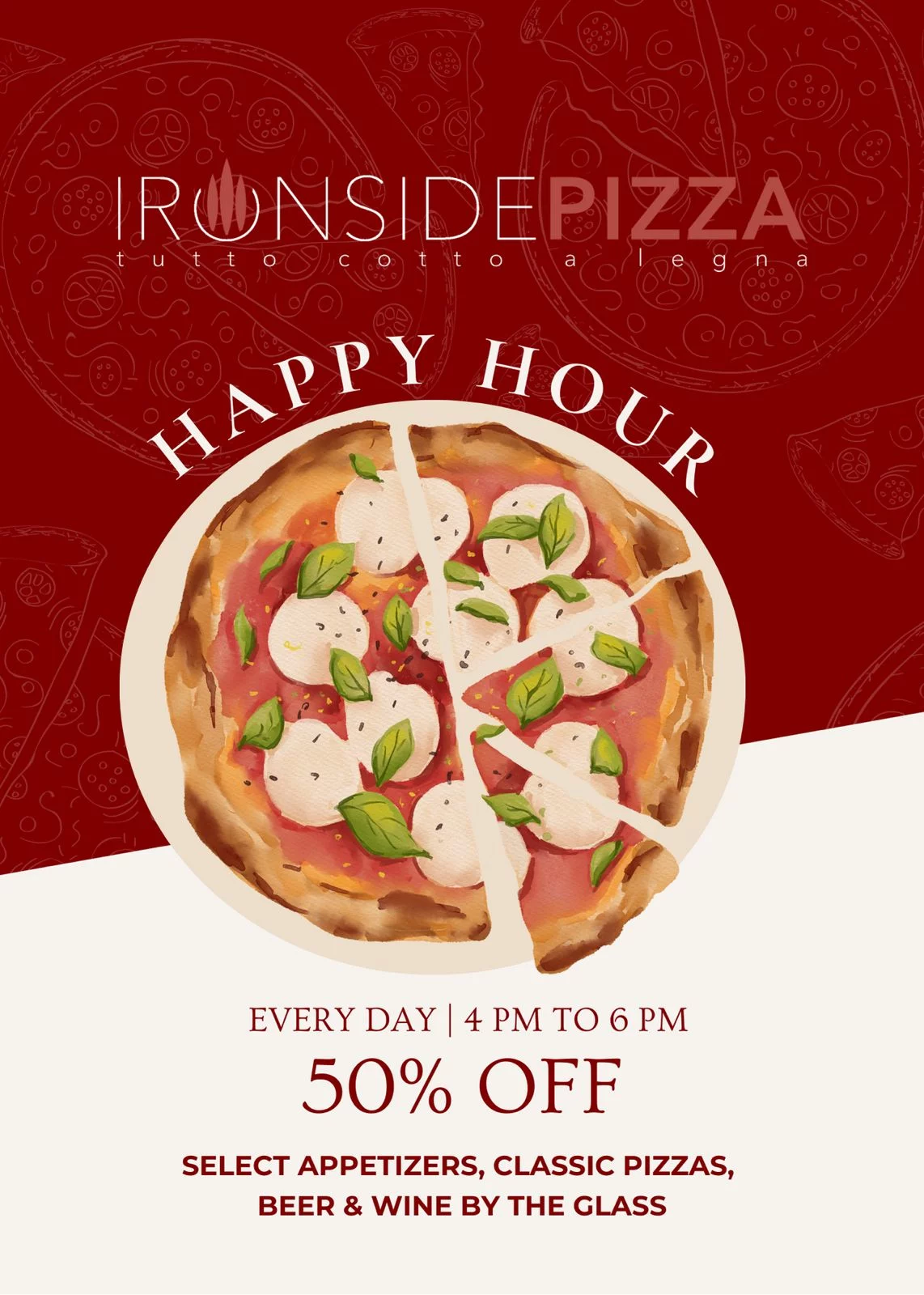
By Jenifer Vogt
“…a whole mountain of grated parmesan, and the people who live on it do nothing all day but make gnocchi and ravioli and cook it in capon broth…”
~Giovanni Boccaccio describing the fictional city of Bengodi in The Decameron, 1351
If you don’t think Parmigiano Reggiano makes the world a better place, imagine this scenario. You and a friend have met for dinner at your favorite authentic Italian family restaurant to enjoy a good meal and unwind after a long work week. You know the restaurant you chose — much like Ironside Pizza — makes their pasta in-house, and the waiters never make you feel rushed. They magically appear when you need them, but never hover when you don’t.
You’re savoring delectable glasses of wine, munching on crostini, and having an interesting conversation while patiently awaiting your primi piatti. On this night, you’ve ordered your favorite — risotto, which you’ve thought about all week because it was so delicious on your last visit that you can still taste it.
The Italian waiter approaches your table with a serving tray and the profumo reaches you. You inhale, sigh, and think about how much you love Italian food and the super-light lunch you had so you’d really enjoy this meal. The server places the steaming hot plate of risotto in front of you…and you wait.
Wait. You look up at him, puzzled. Then, you look around to see if perhaps there’s another waiter nearby ready to do what you’re waiting for.
“Can I have some cheese, please,” you ask politely.
Then your waiter — who has been perfect up till now — looks at you with deep sympathy in his eyes, apologizes, and politely replies, in that mellifluous Italian accent that you love so much, “I am sooo sorry signorina, but we have no Parmigiano tonight. There was a problem with our delivery.”
You stare back at him blankly. It takes a minute for what he’s saying to register because you’ve never encountered this situation before, and your brain needs time to calculate how much less you’ll enjoy your risotto without the cheese.
Allora…. there’s no need to worry because this scenario is imaginary. The two products that are a 99.9 percent sure thing at any authentic Italian restaurant worth your while are wine and Parmigiano Reggiano. However, when you’re forced to think about what food might taste like without the umami, nutty, creamy, slightly crystally, sweet-and-salty balanced flavor of this complex, aged cheese, you really get how much it heightens the pleasure of so many Italian dishes.
Many a waiter has politely stood tableside grating cheese for an eager customer, while silently wondering when they will say, “when.” Be grateful for that stiff-upper-lip stoicism the next time one does this for you because it’s not as easy as it looks. People love Parmigiano so much there’s a discussion thread on Reddit, a popular online community, that has over 46k reactions and over 6,000 comments from waiters sharing their stories of the longest they’ve ever grated cheese before the customer told them to stop.
Thank Clever Italian Monks for Parmigiano Reggiano

Like almost every other famous food from Italy, the production of Parmigiano Reggiano is considered a form of art and there’s a story behind the the origin of this cheese that may have been sent straight from heaven. During the Middle Ages in the province of Parma in Italy, the monastic, cheese-loving orders of the black-cowled Benedictine Monks and the white-cowled Cistercian monks joined forces to tackle the dilemma of how to create a tasty cheese that would last in this pre-fridge, rural and bucolic world in which they lived.
Fortunately, these monks raised their own cows and were near what were then the Salsomaggiore salt mines. They realized they could pair the milk from their cows and the salt from the mines to create a paste-like cheese, form a large wheel with it, and that the more it aged, the better it tasted. Ta-da – Parmigiano Reggiano was born!
The first recorded sale of this specialty cheese dates to Genoa in 1254. From that, a divinely ordained cottage industry was born and by the 14th century, the cheese was being sold throughout Italy.
By the 15th century, abbeys and feudal lords in the Emilia region, where Parma is located, contributed to the development of the cheese and by the 16th century more sophisticated production methods were being used and the Parmigiano Reggiano wheels had gotten bigger. Increasing demand led the producers to turn their sights to exporting the cheese throughout Europe.
How the Italians Protect Parmigiano Reggiano from Fraudulent Competition
While it was a good thing that Parmigiano Reggiano became so popular that production escalated to meet the demand from buyers around the world, there was a downside. Criminals were making and selling cheese knockoffs, the same way they now produce Gucci knockoffs. These forgeries cut into the profits of manufacturers who had passed on the cheese-making traditions from generation to generation and put their heart and soul into every wheel.
By August 7, 1612, the Duke of Parma had had enough. He signed a deed to designate the official production areas within Parma where the cheese must be made to be stamped, “from Parma.” This marked the first Designation of Origin, which later became the Denominazione d’Origine Protetta, or the DOP stamp that now marks the authenticity of Italian products sold throughout the world.
Understanding DOP and PDO and the Problem of Italian-Sounding Products
When countries are viewed in the context of brands, Italy is among the top ten, but that placement comes at the high cost of 120 billion euros in fake Italian products being sold throughout the world. In June of 2022, Italy reported that over two-thirds of Italian food products sold outside Italy are fake, and the Ukraine war has exacerbated the problem. Parmigiano Reggiano and Grana Padana are the two most imitated fake products. In the U.S. alone, there are 40 billion euro worth of fake, Italian-sounding products being sold.
Toscana Divino Hospitality Group as holder of some of the best Italian restaurants in Miami has been collaborating with the Italy-America Chamber of Commerce, Southeast on The Extraordinary Italian Taste initiative that’s financed by the Italian Ministry of Foreign Affairs and implemented globally by Italian Chambers of Commerce around the world. Their goal is to combat the production of fraudulent Italian products by educating consumers. Each Chamber partners with local Italian food producers, Italian consortiums, Italian chefs and restaurants, and wine and beverage trade to present educational events that teach the public and the media how to differentiate between authentic and Italian-sounding products.
These Italian-sounding products are omnipresent, but most consumers don’t realize it. Take, for example, a popular American grocery chain that produces a cheese that looks very similar to Parmigiano Reggiano. It’s packaged as a thick, triangular slice, just like one would see the real one packaged at a fine cheese market or specialty grocery store. There’s even an Italian flag on the label, but if one were to inspect it closely, what looks like a “Made in Italy” stamp instead reads, “Influenced by Italy.”
Legally, the grocer can claim they’re not doing anything wrong because they’re not saying the cheese is made in Italy, yet they package it in a way that the average consumer thinks they’re buying Italian cheese when, really, they’re just buying American cheese with an Italian flag on it. Considering the innovations, traditions, specialty production methods, generations of family producers and the passion Italians put into every food product they create, rip-offs directly hurt the Italian people. Though Italy’s economy bounced back after Covid, recent prognostications show it facing the same risk of recession the U.S. is bracing for.

It’s important to also understand that Parmesan and Parmigiano Reggiano are not the same. For a product to be labeled as Parmigiano Reggiano it must be produced in Italy in the Parma region and meet the Italian laws that govern Denominazione d’Origine Protetta, which is abbreviated as DOP. This could be translated into English as the Protected Designation of Origin, which is what the EU designation is called and abbreviated as PDO and legally protects food products under the laws of the European Union. So, DOP and PDO are often used interchangeably to define and protect a product that has been Made in Italy. Parmigiano Reggiano was officially recognized by the EU as a PDO in 1996.
The goal for the EU PDO regulations, “…is to protect the names of specific products to promote their unique characteristics, linked to their geographical origin as well as traditional know-how.” While there are tasty Parmesan cheeses, they are not the same as Parmigiano Reggiano. The quality of the Parmigiano Reggiano is strictly governed and protected and is superior in flavor and quality to Parmesan made outside of Italy. Parmigiano Reggiano must not contain any additives and preservatives and is only made with three natural ingredients: milk, salt and rennet. The rennet used is an animal enzyme that helps with fermentation. The cheese is aged for 2-4 years.
Soon after Italy created its DOP law in 1954, the Consorzio del Formaggio Parmigiano-Reggiano, which translates into English as the Parmigiano Reggiano Cheese Consortium, was created. The role of the consortium is to unite manufacturers to protect the authenticity of the product and promote it around the world. There are consortiums like this for many of Italy’s most famous food products, including another product from Parma, the much-loved Prosciutto di Parma. They’re often seen next to each other on those in-trend charcuterie boards.
Since 2015, Parma has been recognized by UNESCO as a Creative City of Gastronomy and it’s also the location for CIBUS, the most significant trade fair in the world for Italian food. It’s located in Emilia-Romagna, a region in the north of Italy above the Tuscany region, and it’s not far from the City of Bologna, which was named the Food Capital of the World in 2022 by Condé Nast Traveler.
The Italians Created a Museum for Parmigiano Reggiano
With all the laws, associations, and governing bodies, one might think Italy couldn’t take this cheese any more seriously but think again. They created a museum you can visit that is entirely dedicated to Parmigiano Reggiano and it’s housed within a circular cheese-making factory that dates back to 1848.

The structure had to be renovated to accommodate the museum and it now holds a café and a retail shop where Parmigiano Reggiano cheese and accessories can be purchased. It also has exhibition space and offers visitors a variety of exhibitions that dive deeply into production methods, traditional and modern tools and the entire history leading to modern times.
It would be more surprising, however, if there wasn’t a museum dedicated to Parmigiano Reggiano because, as the most-awarded cheese in the world, it’s a national treasure.
People Who Live Mindfully Prefer Whole Foods Like Parmigiano Reggiano
In 2017, the University College Dublin released research about the health benefits of cheese. Their findings contradicted what most people had believed up until that point. By studying the impact of dairy products on 1500 Irish people, they concluded that those who consumed the most dairy had a lower body mass index (BMI) and those who chose low-fat dairy products, had higher cholesterol levels. They demonstrated that eating a lot of regular fat cheese does not raise LDL cholesterol levels!

Harvard’s T.H. Chan School of Public Health recognizes cheese as a nutrient-rich dairy food that is a source of calcium, protein, phosphorous, Vitamin B12 and Vitamin A. They cited research that suggests, “…perhaps specific nutrients in cheese may be protective for the heart, like calcium and conjugated linoleic acid, and that the types of saturated fatty acids in cheese have a different effect on the heart than other types such as that in red meat.”
Not all cheese is created equal, however. There’s a significant difference between high- and low-quality cheese and cheese that’s made well and with pure ingredients is exponentially better for one’s health. When one checks a cheese label and sees a plethora of strange-sounding ingredients, it’s not a good sign. Many of the cheeses found in discount grocery stores are now made from vegetable oil, rather than milk, both to save on cost and to extend the shelf life. These types of cheeses can be bad for your health.
People who eat mindfully want to know what goes into their food. They want to know that the ingredients are all-natural, and they want to know where it comes from and how it’s made. They’ll pay more for higher quality food because they understand that, if saving money on less expensive food products means more trips to the doctor, in the end, there’s really no cost savings. There’s just the link between bad health fueled by bad food choices.
In Italy, there’s no guessing about what goes into food or how it’s made because of strict laws that set a high bar for quality and consistency, and because of the pride and passion of the Italian people who make these products. All these reasons make Parmigiano Reggiano one of the world’s most mindful food choices, which unequivocally elevates the taste of so many dishes that its’ hard to fathom enjoying food as much without it.
Buon appetito!









